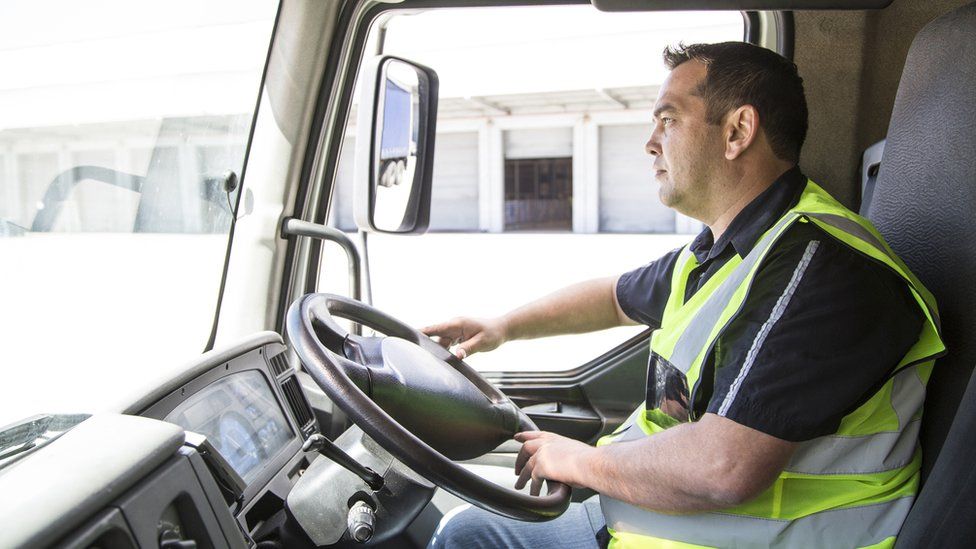Fewer drivers are leaving the profession, Logistics UK says, but more action is needed to attract recruits.

Image source, Getty Images
There are early signs the shortage of lorry drivers will improve, a trade association has said.
Logistics UK, which represents freight and haulage businesses, said the number of drivers leaving the profession had begun to ease.
The group also highlighted more trainees coming through the testing system as a cause for optimism.
However, it said more action was needed by the government and industry to make the sector attractive to new recruits.
Many UK sectors, from petrol stations to supermarkets, have experienced problems with deliveries due to the chronic shortage of lorry drivers.
The shortage of drivers is one of the reasons retailers have warned that consumers will have a reduced choice of food and drink at Christmas.
Logistics UK’s report said that by early autumn there were 44,000 fewer HGV drivers compared to the same time in 2019.
But there has been a 25.6% increase in HGV driver tests from the July to September 2019 period compared to the same period in 2021 and a three-fold increase in applications for vocational provisional licences.
Average driver pay increased by 10% in the nine months to October 2021, the trade body said.
Elizabeth de Jong, policy director at Logistics UK, said the sector was seeing “green shoots” of recovery, and that in a few months, with more drivers trained, there will be an improvement in overall numbers.
“It is still a challenging time, there is still an acute shortage of drivers certainly but there a number of signs of improvement that could be coming,” she said.
“We’re seeing hope that more people are beginning to enter the industry, but we’ve got to keep attracting them by really improving the facilities.”
She said that a lack of roadside facilities may be one of the reasons the industry is “seeing higher proportions of young people leaving”.
Ms de Jong said there had not yet been an increase in the number of drivers employed, which would be the most important indicator that the situation had improved.
She also said she expects to see fewer deliveries due to the continuing shortage of drivers and other logistics workers, which could result in smaller ranges of products and difficulties restocking.

HGV driver Marc Hanks, from Reading, said the pay is still not enough for many workers.
Though he said he loved the job, he explained that a factor for those leaving is that some companies expect drivers to work maximum hours, with pay “not in proportion”.

Image source, Marc Hanks
“Then there’s the facilities and people’s attitude towards drivers – you get abused on a regular basis,” he explained.
“Lots of places don’t allow you to use their facilities, like coffee and tea, even the loos in some places.”
In a past job where Mr Hanks used to sleep in the truck every night, he also found roadside facilities could be dirty.


This report doesn’t suggest the driver shortage is anywhere near being solved, having been years in the making. There’s no quick fix when it comes to reversing the decline in the workforce. But the report does identify early signs of progress.
Speaking to haulage companies this week, some said they were doing OK. Although they had increased pay, in line with the market. Some are coming up with their own initiatives in a bid to attract and train new drivers.
Others were still feeling extremely stretched and worried, as they battled recruitment difficulties and, in some cases, Covid-related absences.
One pointed out that even if more people are now entering the industry and passing their test, a newly-qualified driver can take months to properly get on the road.
Drivers say roadside conditions are a particular problem. Government and industry both say they’re putting effort into addressing this.

In response to the report, a government spokesperson said: “We are pleased that Logistics UK is seeing early signs that the shortage of HGV drivers is improving.”
Previously the government announced a string of measures to address the shortage this year, including new skills bootcamps and temporary visas.
“These measures – combined with a deserved improvement in pay and conditions – are working, with a huge increase seen in vocational licences issued and HGV tests conducted compared to before the pandemic, and there is now spare capacity in the testing system,” the spokesperson added.